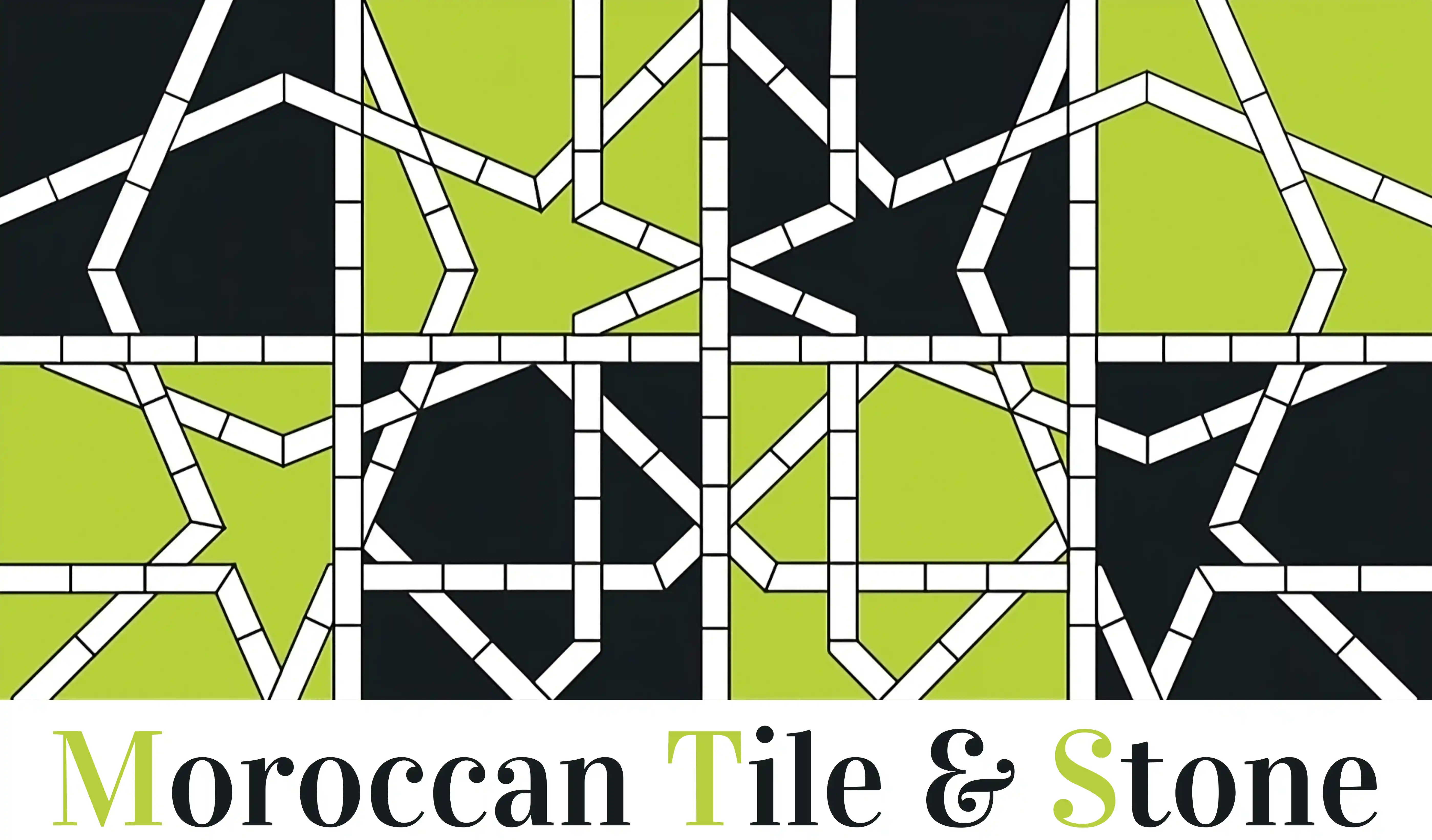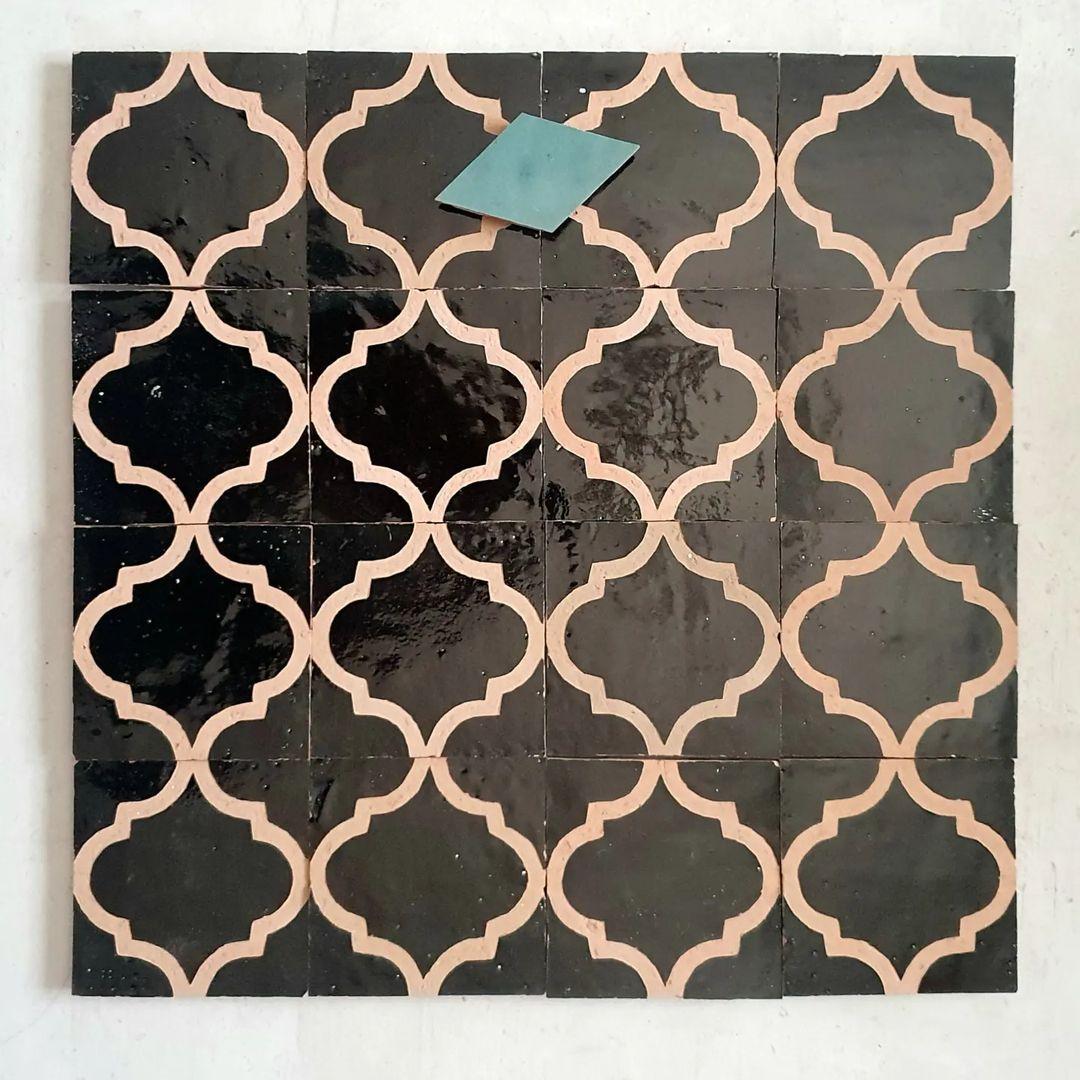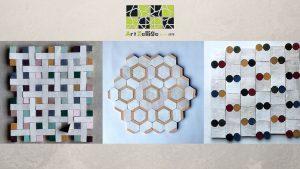Zellige is a Handcrafted Clay Tile that Originates from Morocco
An Overview of the Zellige
The zellige (also named zellij, zellige terracotta tile, and Moroccan tiles) is a history filled product that is made in Morocco of non-refined natural clay. In other words, the raw material of Zelliges tiles is clay, similar to Moroccan pottery. Concerning the clay, it looks like stones in nature. They are destined to be kept on a basin for further treatment for a day and a night. This key element follows a detailed process to come up with the beautiful Zellige pieces after some days. Based on traditions, men use their legs and arms to work smooth the texture, soften it, and unify it.
The Zellige has an artisanal appeal to add exquisite beauty to buildings and has spiritual roots. This has been striking characteristic of the Moroccan architecture for centuries. Its influence was absorbed from sacred Islamic text and religious concepts. Its mosaic designs are available in tons of colors and are produced into tiny individual shapes using hand-cut tiles. They are trending!
Many mathematical geometries are used as puzzles that gather a specific contemporary design. In this phase, the small pieces that were ready from a previous stage need to processed again. They will be used and gathered together by shapes. The colors may be different even though the pieces are of the same shape. The craftsmen take the responsibility of preparing a guide to the construction. They need to upside down each piece on a smooth floor. Thereafter, the cement needs to be put on the puzzle prepared and kept dry. In short, the Moroccan Zellige needs artistic eyes that are aware of the combination of colors that fit together and a sense of order to bring up mesmerizing pieces.
Zellige Tiles Origin & Historical Background
Resorting to the Zellige in architecture is a technique that dates back to the 10th century in North Africa and Andalusia. In the first half of the 14th century, it has become widely used in Spain and the Maghrib. Morocco's Merinid dynasty dominated this distinctive art form from the 14th to the 15th centuries. It is one of the popular elements that has been used for several centuries. The Crusades eventually brought an end to this Islamic splendor in Spain, but the artisans continued their craft in Morocco. The latter managed to become a beautifully diverse country in culture and art due to all the efforts made in this sector. it is one of the popular elements that has been used for several centuries.
Zellige, a Symbol of Sophistication
It is worth mentioning that the Zellige played a huge role in public image of Morocco. The artistic expression of this culture managed to gain the heart of successive generations, especially after Morocco’s Merinid Dynasty. Years after, it has become more common among the population. In the 10th century, colors were more oriented to earth-toned and white, while in the 20th century, natural colors and older enamels are more to be utilized.
The Moroccan Capital of the Zellige
Concerning the Zellige tilework, it is mainly present within typical tiny shops in Fez and Tetouan. However, Fez is considered the Moroccan capital of zellige by excellence due to its historical heritage. For more clarification, Fez is a Moroccan city that was founded in the 9th century. It kept reaching its heights many years after. It has remained the cultural and spiritual center of the country till our current time. The Medina of Fez is known for its high production and assembly of that decorative art elements. It is also poplar for spreading it to other Moroccan cities. This makes of Fez the owner of this art.
The Zellige of Fez, a National Heritage
The most important sector in Fez is handicrafts. It plays a vital role in shaping the development of the city whitin the industry. Furthermore, an important fact to cite is that 4 leaders of 10 families in Fez take part in the craft. Additionally, back in 2015, the Zellige of Fez preserved its national heritage by registering in the Vienna Classification of Figurative Elements of the World Intellectual Property Organization. This move improves the global popularity of this pattern. This is because more people are aware of its originality, quality, and features that capture the heart of any person who explore it. As a result, this handcrafted clay tile is considered decorative and elegant. Its richness in patterns, complex geometry, and color palette, which makes it one of the best forms of Moroccan culture.
Zellige Use as an Architecture Universal Value
The Zellige take part in the highest ways to showcase art in the Islamic world and the Moroccan culture. It is known worldwide as a Moroccan tradition mostly opted in Riads’ architecture. Riads are popular for their mesmerizing structure that has an indoor courtyard, plants, open- ceilings, and traditional mosaics. For this reason, the Zellige has grabbed the attention of many international designers. They got inspired by its distinctive richness and considered it an opportunity to benefit from a design trend. It is important to point out that the Zellige exists in different shapes within floors, roofs, and walls of different riads in Fez and other Moroccan cities.
Zellige used in Riads
Nowadays, riads are considered luxury houses that multiple residents and foreign travelers love to visit to enjoy their vacations. The riads are still using a similar design and structure even though the presence of a simple style and modern touch. Their architecture is quickly distinguished from other homes due to the privacy features that it includes. To clarify, riads are different from regular buildings on many levels. First, riads have openings that are facing the interior, not windows facing the exterior. Second, this type of architecture is supported by the Islamic conceptions of intimacy since it is providing privacy. Third, riads generally contain plants, trees, a courtyard, a central fountain, and more.
Zellige used in Palaces and Mosques
Palaces and mosques also contain outstanding Zellign elements. Visitors spend amazing experiences while exploring the diversity in culture of the Moroccan country and its cultural heritage when it comes to the Art of Pottery and Zellige Tile Design. In recent years, tourists’ interest in the cited locations enhanced brought new challenges to local communities, encouraged them to resort to a wave of innovations, and accepted foreign investments in the Restauration domain. Other than the fact Zellige is amazing on old houses such as riads, they look perfect on modern houses as well. Meaning that it works no matter the style of a home, modern or traditional. Thus, Zellige's characteristic is not necessarily tied to a specific building type, but rather can be used in both. The colors, shapes, and installation patterns have a big role in the final delivery and result.
 Riad project juste by naturel
Riad project juste by naturel
Types of Zellige Decorations
As mentioned previously in the previous section, many forms and colors are available for Zellige. Talking about the trending mosaics and colors used, the majority of colors are simple: black, brown, yellow, white, green, and blue. However, when the game with colors is not good, the results may not be satisfying. It is all about the way you pair it with finishes! Thus, choosing a simple yet eye-catching design in a classical or modern look to the building is the best decision that can be made.
Zellige as an Islamic Identity
The Moroccan Zellige is one of the best artisanal work within Morocco since that diverse compinations of piece can be produced with a sense of patience and creaticity that is put in the infinite designs. Other than that, the main types of the Moroccan square Zellige include calligraphy decoration, floral decoration, and geometric decoration. In short, the islamic art is full of life, as simple as that!
Calligraphy Decoration
The calligraphy decoration deeply reflects the historical depth and identity of the Islamic civilization because it has Arabic calligraphy with Quranic text grandeur and majesty. This type of Zellige is more common in Islamic art, especially at Fez, Meknes, and Marrakech.
Floral Decoration
The floral decoration (also called arabesque), uses several symmetrical plant elements to come up with a final decoration. The latter is following a given style and rules to draw out plants and flowers drawings.
Geometric Decoration
As for geometric decoration, it adopts principles, mathematics, and the reduplication of ornamental items. Moreover, it is considered the most sophisticated Zellig decoration since that it is a widespread and prominent motif even though its complexity. This type of Zellige is of high significance in Islamic art as well and rely mainly on regular polygons. Often, in western Zellij, a mix of the following colors is adopted in their designs by setting them against a white ground: light brown, greens, yellows, turquoise, blues, and black. Staying in the same context, under the Marinid and Nasrid dynasties, various forms and patterns were used to build the architecture decorations to people with high power. For example, a mix of star compositions are inserted between designs to bring an attracting beautiful piece: six-pointed stars, eight pointed stars, eleven pointed stars, etc.

Production Process of the Zellige on Tetouan
About to the process of production of the Zellige on Tetouan, it follows multiple steps that must be carried out with details. As a start, lumps of clay are brought to specific basins that contain water and kept there for at least one day. These basins can either be circular or rectangular, and they are called Ezouba. Thereafter comes the step of cleaning so that the lumps of clay no longer contain no impurities. When it becomes smooth, the clay can be formed in a mold and to be cut into geometric forms after a while. The next stage comprises drying up the pieces of clay in a warm weather for approximately 2 days, staying in cold weather for 7 days maximum, and then being subject to the oven under a very high temperature. The last step consists of installing the patterns after painting them.
Production Process of Morocco's Zellige on the Medina of Fez
The Moroccan Zellige is produced on Fez in a way that is different from the one used in Tetouan. The pieces of lay will go through a phase called the etedwar. The latter is showcased in two oven levels. The lower level is the Essgen, while the upper level allows the heat to reach the pieces. It is significant to mention that workers cut the pieces into squares of 10 x 10 cm after dividing the blocks. After that, they get dried after a while. The cutting process is important because it has to be completed with a detailed manner. The pieces should look perfect in size.
By that time, the ready pieces can be painted by the zuwaak at the house of leekama. They are in fact places in baskets depending on the color form and design. In normal, they may be hundrands of baskets with different small parts that help in the organization of the Zellige elements. The person in charge of the painting prepares the color regularly. Red, green, blue, and white represent the widely used colors in such a process. As for the Medina of Fez, it is strongly characterized by a light green zellige, contrary to the Tetouan city that resorts to patterns with dark colors. After the painting of the pieces, they are put back into the oven once again so that their names become lezehri instead of the laajoura.
The Zellige Specialities
When talking about the Zellige, the Zllaygi is a must-known person in the production process. The zllaygi is in charge of three special techniques that take place: nekash, ferash, and feragh. In other words, his responsibilities mainly consists of sculpting out the pieces produced into various sizes and pieces. One of the sharp tools used by the Zllaygi on this journey is the lmenkhash. The latter allows him to deliver his art in the best way possible. The process includes working on 300 carved forms that are present. These formed named the ferma, are placed in the patterns when ready. Then comes the phase of facing each carved form into the ground, sprinkling cement, water, and sand on it. This mixture is key to reaching a panel that is ready for installation.





